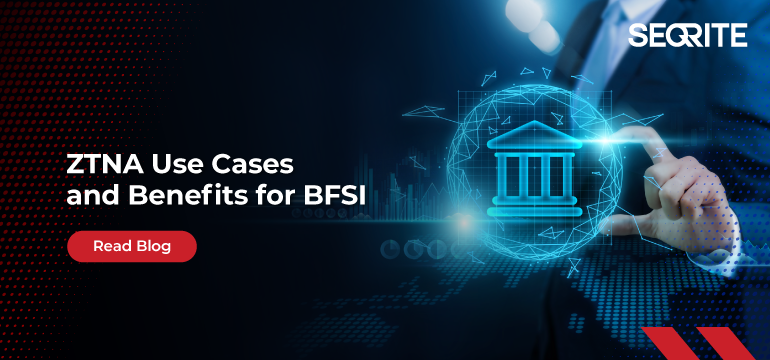In an era of digital banking, cloud migration, and a growing cyber threat landscape, traditional perimeter-based security models are no longer sufficient for the Banking, Financial Services, and Insurance (BFSI) sector. Enter Zero Trust Network Access (ZTNA) — a modern security framework that aligns perfectly with the BFSI industry’s need for robust, scalable, and compliant cybersecurity practices.
This blog explores the key use cases and benefits of ZTNA for BFSI organizations.
ZTNA Use Cases for BFSI
-
Secure Remote Access for Employees
With hybrid and remote work becoming the norm, financial institutions must ensure secure access to critical applications and data outside corporate networks. ZTNA allows secure, identity-based access without exposing internal resources to the public internet. This ensures that only authenticated and authorized users can access specific resources, reducing attack surfaces and preventing lateral movement by malicious actors.
-
Protect Customer Data Using Least Privileged Access
ZTNA enforces the principle of least privilege, granting users access only to the resources necessary for their roles. This granular control is vital in BFSI, where customer financial data is highly sensitive. By limiting access based on contextual parameters such as user identity, device health, and location, ZTNA drastically reduces the chances of data leakage or internal misuse.
-
Compliance with Regulatory Requirements
The BFSI sector is governed by stringent regulations such as RBI guidelines, PCI DSS, GDPR, and more. ZTNA provides centralized visibility, detailed audit logs, and fine-grained access control—all critical for meeting regulatory requirements. It also helps institutions demonstrate proactive data protection measures during audits and assessments.
-
Vendor and Third-Party Access Management
Banks and insurers frequently engage with external vendors, consultants, and partners. Traditional VPNs provide broad access once a connection is established, posing a significant security risk. ZTNA addresses this by granting secure, time-bound, and purpose-specific access to third parties—without ever bringing them inside the trusted network perimeter.
Key Benefits of ZTNA for BFSI
-
Reduced Risk of Data Breaches
By minimizing the attack surface and verifying every user and device before granting access, ZTNA significantly lowers the risk of unauthorized access and data breaches. Since applications are never directly exposed to the internet, ZTNA also protects against exploitation of vulnerabilities in public-facing assets.
-
Improved Compliance Posture
ZTNA simplifies compliance by offering audit-ready logs, consistent policy enforcement, and better visibility into user activity. BFSI firms can use these capabilities to ensure adherence to local and global regulations and quickly respond to compliance audits with accurate data.
-
Enhanced Customer Trust and Loyalty
Security breaches in financial institutions can erode customer trust instantly. By adopting a Zero Trust approach, organizations can demonstrate their commitment to customer data protection, thereby enhancing credibility, loyalty, and long-term customer relationships.
-
Cost Savings on Legacy VPNs
Legacy VPN solutions are often complex, expensive, and challenging to scale. ZTNA offers a modern alternative that is more efficient and cost-effective. It eliminates the need for dedicated hardware and reduces operational overhead by centralizing policy management in the cloud.
-
Scalability for Digital Transformation
As BFSI institutions embrace digital transformation—be it cloud adoption, mobile banking, or FinTech partnerships—ZTNA provides a scalable, cloud-native security model that grows with the business. It supports rapid onboarding of new users, apps, and services without compromising on security.
Final Thoughts
ZTNA is more than just a security upgrade—it’s a strategic enabler for BFSI organizations looking to build resilient, compliant, and customer-centric digital ecosystems. With its ability to secure access for employees, vendors, and partners while ensuring regulatory compliance and data privacy, ZTNA is fast becoming the cornerstone of modern cybersecurity strategies in the financial sector.
Ready to embrace Zero Trust? Identify high-risk access points and gradually implement ZTNA for your most critical systems. The transformation may be phased, but the security gains are immediate and long-lasting.
Seqrite’s Zero Trust Network Access (ZTNA) solution empowers BFSI organizations with secure, seamless, and policy-driven access control tailored for today’s hybrid and regulated environments. Partner with Seqrite to strengthen data protection, streamline compliance, and accelerate your digital transformation journey.




